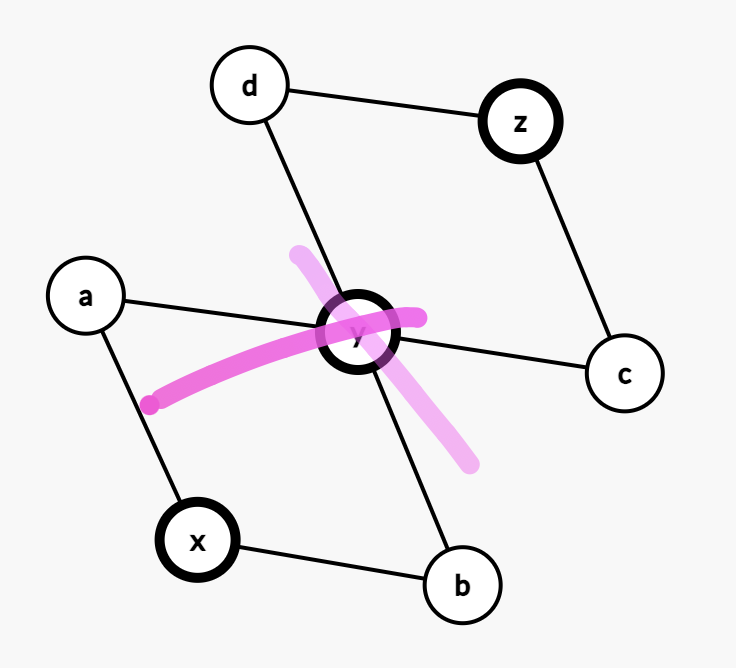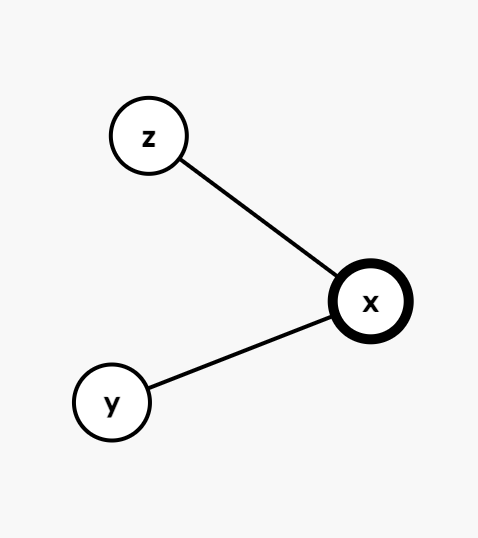Living-Dream 系列笔记 第84期
连通性问题
-
点双连通:在无向图中,删除一个点(不是 \(x\) 或者 \(y\))后,点 \(x\) 和点 \(y\) 仍然能够彼此到达,那么称 \(x\) 和 \(y\) 是点双连通的。
-
边双连通:在无向图中,删除一条边后,点 \(x\) 和点 \(y\) 仍然能够彼此到达,那么称 \(x\) 和 \(y\) 是边双连通的。
性质
-
点双连通不具有传递性,但边双连通具有。

如图,但 \(y\) 被删去之后,虽然 \(x,y\) 以及 \(y,z\) 都是点双连通的,但是 \(x,z\) 却不是点双连通的了。
边双连通具有传递性是因为无论删哪条边 \(x,y\) 和 \(y,z\) 都是边双连通的(由定义易知),这也就是说 \(x,z\) 是边双连通的。
割点
性质:
-
至少三个点的图中才有割点。(易证)

如图,\(x\) 即为该图的割点。
判定:
若搜索树中,有从 \(x\) 到 \(y\) 的连边,当 \(low_y \ge dfn_x\) 时(定义同 tarjan 算法),说明 \(y\) 能到达的最小时间戳是 \(x\) 的时间戳,即 \(y\) 被 \(x\) 与 \(x\) 之前的结点「隔开」, 因此 \(x\) 可能是割点。
只要 \(x\) 不是搜索树的根结点,或者 \(x\) 是根结点 且 \(x\) 的子结点大于 \(1\) 个,那么 \(x\) 就是割点。
P3388 & UVA10199
板子。
code
#include<bits/stdc++.h> using namespace std; const int N=1e5+5; int n,m,cnt,rt; vector<int> G[N],ans; int dfn[N],low[N]; bool cut[N]; void tarjan(int cur){ dfn[cur]=low[cur]=++cnt; int num=0; for(int i:G[cur]){ if(!dfn[i]){ tarjan(i); low[cur]=min(low[cur],low[i]); ++num; if(low[i]>=dfn[cur]&&(cur!=rt||num>1)){ cut[cur]=1; } } else{ low[cur]=min(low[cur],dfn[i]); } } } int main(){ ios::sync_with_stdio(0); cin.tie(0); cin>>n>>m; for(int i=1,u,v;i<=m;i++){ cin>>u>>v; G[u].push_back(v); G[v].push_back(u); } for(int i=1;i<=n;i++) if(!dfn[i]) rt=i,tarjan(i); for(int i=1;i<=n;i++) if(cut[i]) ans.push_back(i); cout<<ans.size()<<'\n'; for(int i:ans) cout<<i<<' '; return 0; }
CF22C
构造题,从简单情况开始考虑。
首先 \(m\) 必须 \(\ge n-1\),否则图不可能联通。
当 \(m=n-1\) 时,显然让 \(v\) 作为根,其他点直接向 \(v\) 连边是最简单的方案,其他方案都可以通过改变树的形态的方式使得其与此方案等价。
接着,当 \(m>n-1\) 时,为了使添加的边尽可能多,我们只能孤立出一个子节点,其他的 \(n-2\) 个子节点连出完全图即可。
于是 \(m\) 的上界即为 \(n-1+\frac{(n-2) \times (n-3)}{2}\),做完了。
code
// // CF22C.cpp // // // Created by _XOFqwq on 2024/11/7. // #include <bits/stdc++.h> using namespace std; int n,m,v; void print(int x){ for (int i=1; i<=n; i++) { if (!m) { return; } if (i!=v&&i!=x) { for (int j=i+1; j<=n; j++) { if (!m) { return; } if (j!=v&&j!=x) { cout<<i<<' '<<j<<'\n',m--; } } } } } int main(){ ios::sync_with_stdio(0); cin.tie(0); cin>>n>>m>>v; if (m<n-1||m>n-1+(n-2)*(n-3)/2) { cout<<-1; } else { for (int i=1; i<=n; i++) { if (i!=v) { cout<<v<<' '<<i<<'\n'; } } m-=n-1; if (v==n) { print(n-1); } else { print(n); } } return 0; }
P3469
容易发现每个点都有一个基础贡献 \(2 \times (n-1)\),只有割点才会产生额外贡献。
对于割点,将它提起来作为根,于是有子树内的联通块和子树外的联通块。子树内的贡献算两次,单点算两次,然后子树外的再算两次即可。具体见代码实现。
code
// // P3469.cpp // // // Created by _XOFqwq on 2024/11/7. // #include <bits/stdc++.h> #define int long long using namespace std; const int N=5e5+5; int n,m,cnt,rt; int siz[N],ans[N]; bool cut[N]; int dfn[N],low[N]; vector<int> G[N]; void tarjan(int cur){ dfn[cur]=low[cur]=++cnt; siz[cur]=1; int num=0,sum=0; for (int i : G[cur]) { if (!dfn[i]) { tarjan(i); siz[cur]+=siz[i]; low[cur]=min(low[cur],low[i]); num++; if (low[i]>=dfn[cur]&&(cur!=rt||num>1)) { sum+=siz[i]; ans[cur]+=siz[i]*(n-siz[i]); //子树内两次 + 子树外一次 + 子树内与单点 cut[cur]=1; } } else { low[cur]=min(low[cur],dfn[i]); } } if (cut[cur]) { ans[cur]+=(n-sum-1)*(sum+1)+n-1; //子树外一次 + 子树外与单点 + 一次单点 } else { ans[cur]=2ll*(n-1); } } signed main(){ ios::sync_with_stdio(0); cin.tie(0); cin>>n>>m; for (int i=1,u,v; i<=m; i++) { cin>>u>>v; G[u].push_back(v); G[v].push_back(u); } rt=1,tarjan(1); for (int i=1; i<=n; i++) { cout<<ans[i]<<'\n'; } return 0; }



【推荐】国内首个AI IDE,深度理解中文开发场景,立即下载体验Trae
【推荐】编程新体验,更懂你的AI,立即体验豆包MarsCode编程助手
【推荐】抖音旗下AI助手豆包,你的智能百科全书,全免费不限次数
【推荐】轻量又高性能的 SSH 工具 IShell:AI 加持,快人一步
· 地球OL攻略 —— 某应届生求职总结
· 周边上新:园子的第一款马克杯温暖上架
· Open-Sora 2.0 重磅开源!
· 提示词工程——AI应用必不可少的技术
· .NET周刊【3月第1期 2025-03-02】